#shōwa era
Text

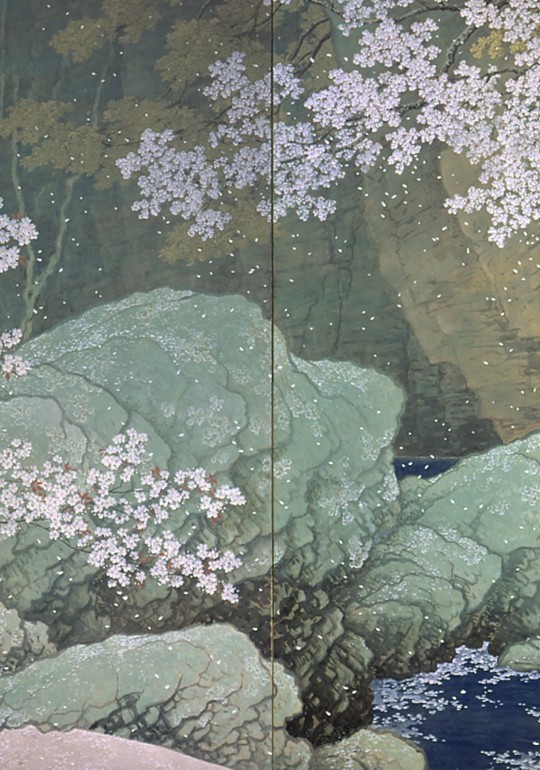
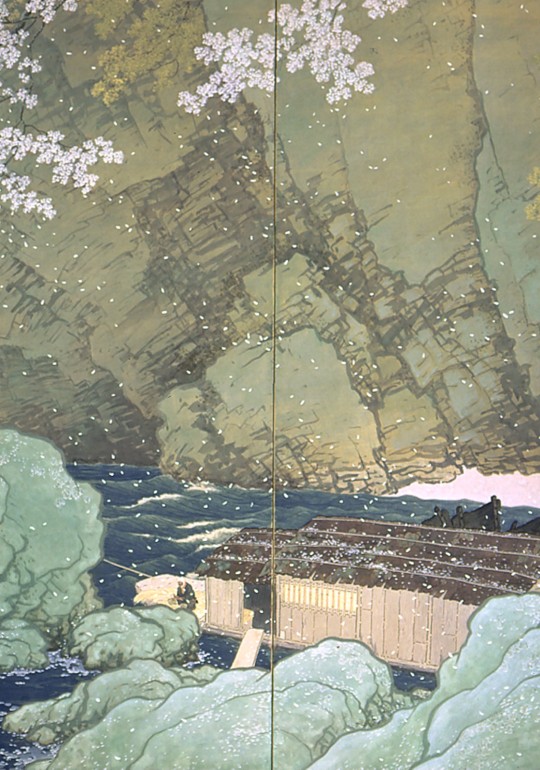
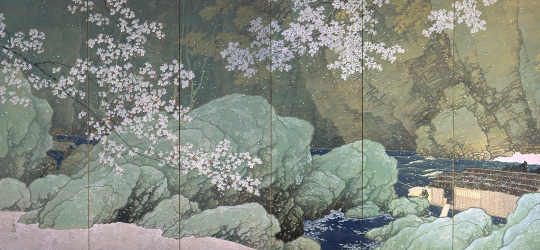
Left panel of the Parting Spring | 1916
Kawai Gyokudō
#Kawai Gyokudō#japanese art#spring#川合 玉堂#行く春#nihonga school#meiji period#shōwa era#japanese painting#1910s#early 20th century#art#byōbu#japanese folding screen#💮💮#art history
115 notes
·
View notes
Photo

Katayama Bokuyō
Oboro. 1927
#katayama bokuyō#art on silk#nihonga style#animal paintings#beautiful nature#blurred style#shōwa era#japanese artist#hiroshima prefectural museum of art
659 notes
·
View notes
Text
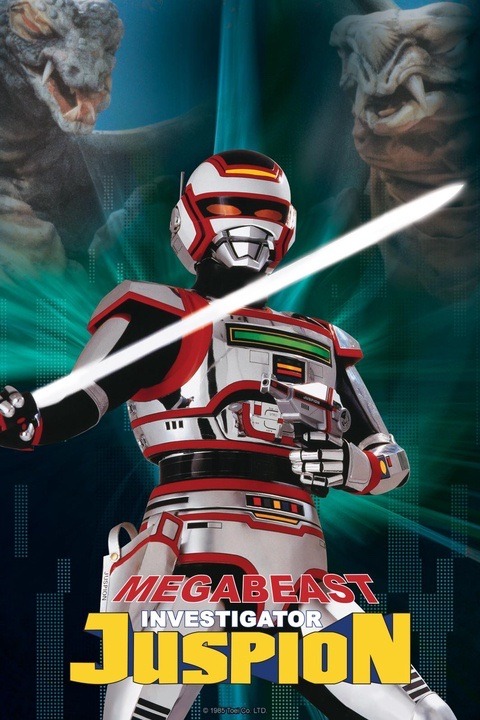
Okay, so I just finished Juspion, and overall it was pretty good. Not perfect mind you, for a lot of the show the story kinda felt like it was either going in circles or nowhere at all, but the characters where enjoyable, the action was fun, and any hero show with a Giant Mecha is worth a watch in my book. This was my first ever Metal Heroes show, as well as my first reel foray in stuff from the Shōwa era, and now I’m excited to check out more from both categories!
Juspion gets a 7/10, easy recommendation.
0 notes
Text
Obscure Anime of The Day:

Shouwa Genroku Rakugo Shinjuu
Aired: 2016
Genres: Comedy, Drama, Historical, Josei, Musik, Romance, Slice of Life
#Showa and Genroku Era Lover's Suicide Through Rakugo#Shouwa Genroku Rakugo Shinjuu#昭和元禄落語心中#Shouwa Genroku Rakugo Shinjuu (2016)#Showa Genroku Rakugo Shinju#Obscure Anime of The Day#anime#josei anime#anime nostalgia#historical anime#rakugo#obscure anime#Shōwa Genroku Rakugo Shinjū
20 notes
·
View notes
Text
So I have a (somewhat goofy) kanji name to use for websites that don't accept kana names, because that's not that uncommon even in the year of our Lord 2024. But I recently encountered something really unusual, something I hadn't seen in nigh on 15 years of living here: a website that required my birth year in the Japanese calendar! As a required field. Wild. Do you know what year you were born?
You probably know that in addition to the Western calendar 西暦 [せいれき], Japan also uses 和暦 [われき] (or 年号 [ねんごう]), which are eras named after the reigning emperor. So when you have to write the date in any official documentation, you often see this.

(Cropped from a random medical intake form on Google Images.)
This a standard field for birthdate, or 生年月日 [せいねんがっぴ]. The characters 明・大・昭・平・令 each stand for an era.
明 for 明治 Meiji, 1868–1912
大 for 大正 Taishō, 1912–1926
昭 for 昭和 Shōwa, 1926–1989
平 for 平成 Heisei, 1989–2019
令 for 令和 Reiwa, 2019 to present
(Plus sometimes 西 for 西暦 )
As an example, I've filled it out for a fire rabbit (a 1987 baby! a very good year), born on tumblr's favorite holiday.

That's Heisei 62 for the year 年, November for the month 月, and 5th for the day 日, giving an age of 36 years (36歳 [さんじゅうろくさい]) and 4 months (4ヶ月 [よんかげつ]).
So what's to stop you from just writing the Western year? Generally, nothing! Lots of people do it (I think). Just make sure to write all four digits to avoid confusion with the one- or two-digit Japanese years and you should be okay....... Except for this one, once in 1.5 decades form that actually made it the required format. I wish I'd thought to take a screenshot! Now I can't even remember where it was because I'm working 12-hour days and my brain is broken!
In conclusion, you can look your birth year up here! The site may look pretty barebones, but it's very useful for converting Japanese numbers, traditional units, etc.
P.S. - I was going to end this post with a birth year poll (because I love polls), but once I started to make it, I realized that anyone who isn't Heisei or Shōwa is basically either a preschooler or a centenarian and is probably not on this website. Oh well.
149 notes
·
View notes
Note
I've started reading The Great Gatsby (I've fallen into the reading classical literature trap 😔. I really need to finish Crime and Punishment.)
Anyhow I think it's really interesting how Asagiri chose to characterize many of the people in BSD. Especially after learning that irl Fitzgerald was more of a cynical person (at least towards the end of his life) than his animated counterpart. And it made me think of all the other characters of the show and how their characterized.
What was Asagiri's purpose as he came together with these characters? Why'd he have some characters act as their irl counterparts while others act more like the characters they wrote or people in their lives?
These aren't really questions that I wanted the answers to they were moreso just thoughts that I had. I'd love to have a peek into this man's mind and how it works
I think a lot of us have fallen into that trap LMAO. This is my favorite topic though. I could talk about this forever because Kafka Asagiri is an interesting person who has integrated a lot of literature into this one series. I don't know what goes on in this man’s mind and I know these aren't literal questions, but I am interested in sharing what I know!
As you've pointed out, some characters do act more like the people in these works written by them than the actual people. BSD isn't purely just taking these authors, their relationships, and then implementing them just like that. it also takes these authors’ literary personas, their impact socially, and their works to make them into who they are. Asagiri is doing this because it makes it more interesting, but also imagine writing about this authors where most of them lived depressing lives with qualities that don’t make uh, the type of story you want to tell.
I’m impressed with how creative he is.
I’m trying to limit myself on how much I should talk about this, but I fear that I’ll leave out important bits about how Asagiri incorporates these people into the work. I’m also just jittering and excited. Like I almost forgot to bring up the fact the reason BSD has a war narrative is because it takes Japanese authors from Meiji to Shōwa era, so about the time Western influence kicked in, forcing them to modernize and keep up with the rest of the world during what is a fairly short time for huge development like this, to post-war Japan where, you know, the Occupation of Japan is happening and they have to intake the traumatic repercussions of everything before that.
This can make The Great War functionally WW2, but obviously not a one to one match. I’m not a historian or anything, but this should come to mind for anyone who’s in the know about some Japanese history. Now that I’m bringing it up though, Mori’s attitude during the flashback with Yosano is put into context because he pretty much says himself that he needs his country to realize that they keep up with the rest of the world and that the battlefield is changing, and real life Japan did not care about how they did that.
With N, Chuuya, and Stormbringer too. I’m almost hesitant to bring this up because it’s so serious, but yes, Japan did do lethal human experimentation for that same purpose to keep up with the rest of the world and prove themselves.
Ahh, I went off track. Sorry, we were talking about how Asagiri writes characters, right? There is a lot of crossover between the real authors and their writing, so it’s sorta hard to tell with people like Dazai where the work influence ends and the the real person begins.
For me currently in my classic lit research period, I’m almost upset at myself for barley reading anything by Ryuunosuke Akutagawa because he’s my favorite character. I’ve just been so caught up doing my Oda Sakunosuke essay that I don’t have too much time for other authors. I’ve also picked up “The Similitude of Blossoms: A Critical Biography of Izumi Kyōka” recently (and A New Hamlet by Osamu Dazai, but that’s not important).
Ah, how much should I talk about.… hmm… how about Chuuya as an example of Literary Voice vs Real Person…. Lucy Montgomery and Edgar Allen Poe for Social Impact (for Japan specifically)…. and then.. Oh whatever, I’ll figure it out. One day I’ll talk about Kyouka, but not now. I’d feel ill prepared.
If you’ve ever read a poem by Chuuya Nakahara, taken in the emotion and deep feeling, and then found any fun facts about his interactions with other authors, there’s a huge contrast between those two modes that can be jarring. Im sure you can tell how that carries over to BSD. I’m impressed by how Asagiri is able to balance both the brash attitude of Chuuya and the inner literary voice that voices the emotion and care he has in him.
Edgar Allen Poe is slightly more obvious than Lucy’s influence (or maybe it’s Lucy’s, ah it depends), but both pop out at you when it’s pointed out. He was one of the first American authors to be introduced to Japan and fairly popular, but mainly we would point to Edogawa Ranpo as the most blatantly influenced by him and who his name is quite literally attached to. While Lucy Montgomery isn’t attached to anyone in particular, Anne of The Green Gables was wildly distributed in Japan when there were few english children books and became a hit.
There’s a television series too if you search for it. Any redhead, pigtail-braided girl you see in some Japanese media is because of her! It’s probably why these two have the most presence in the story currently compared to other members of the Guild and work with the Agency at times.
There are times when Asagiri will use influences outside of the author’s own catalog to create them, some literary like Albert Camus’s The Stranger and The Myth of Sisyphus (in writing characters like Dazai or Fyodor, I could make a post about that), and some just of his own anime/manga interests in other series like Jojo, Cowboy Bebop, Black Lagoon, etc. if you’re familiar.
I’d feel bad if I don’t at least show one example of this so, how about an Odasaku example with The Long Goodbye by Reymond Chandler? I was going to avoid talking about him until the essay, but I can’t help myself. Many have pointed out these parallels before, but Asagiri did point it to be his favorite book last year in an interview.
If you’ve noticed that the presentation for Dark Era in the anime comes off like a Noir film just like how Untold Origins came off like a black and white samurai film, good job! The Long Goodbye is a Noir novel about a detective named Phillip Marlowe who is unable to let go of a case involving a friend that was accused of murdering his own wife, but supposedly commits suicide and confesses to it before Marlowe is able to leave custody. By the end of the book, he uncovers the real perpetuator (a past lover of Terry Lennox’s before he was ever called by that name) and finds out where Lennox really is by poking into the story of where the message he got was sent.
He comes in with a new look and identity, and he asks if it’s too early for a gimlet. They say their last few words to each other, Marlowe flipping back and forth from acknowledging him as Terry Lennox and as a person he never knew, and then Marlowe tells him that “he’s not here anymore”. Marlowe had already told him goodbye when it was sad and lonely, so Lennox does the same here. That ends that mutual, long goodbye and he never sees Lennox again.
The immediate response I’ve see about this is how it parallels the relationship between Dazai and Odasaku. In The Day I Picked Up Dazai, just like how Marlowe brings him to his home to clean him up and meet up at the same bar for the next few months of their friendship, Odasaku also does so with Dazai and drinks a Gimlet for reasons he doesn’t know. In reality, Gimlets are a representation of the friendship between Marlowe and Lennox as it’s Lennox’s favorite drink. It makes it a little painful when Marlowe ignores him when he ask to go get a gimlet at that same bar they always went.

BEAST is more hyper specific about it by having Dazai ask the same question that Lennox asks when he gets smoked out and Odasaku asking for a gimlet with no bitters, which is specifically how Lennox takes it. Odasaku does not drink the gimlet at all though, showing that there is not friendship to start or accept or say goodbye to, as Lennox does ask Marlowe to drink a Gimlet to say goodbye to him in the letter. Just like TDIPUD is like their beginning, BEAST is their ending without ending because BEAST Dazai is not the same person he was friends with.
Odasaku fulfills being a detective and Dazai is the tragic friend with a past he doesn’t say anything about. Great. Now what I think people are missing when they entirely focus on Odasaku and Dazai when they talk about Lennox and Marlowe is that Lennox is narratively also Andre Gide.
If we were to split Lennox into three people just like his three identities, this is what it would look like:
The Friend: You help him out and don’t judge for his faults, in turn you go out to a bar with each other. It’s uneasy, but it’s worth a lot to the both of you. Eventually you have to part ways in death. (Dazai & Terry Lennox)
The Unknown: Is he someone you know? He acts like it, but he looks nothing like what you’ve encounter before. Maybe in some world you were, but that’s not now and it’s too late for this goodbye to be playing out. You let it happened though and you never see him again when he walks out that door. (BEAST Dazai & “Señor Maioranos”)
The Soldier: The past is right around the corner and its come to bite you in the ass. White hair and war memories haunting him with a scar as a reminder, he’s a reflection of you but maybe not. Who knows? (Andre Gide & “Paul Marston.”)
The initials “P.M.” of both his past name and Phillip Marlowe’s is meant to clue in how Eileen (the past lover) is connected to Lennox by her thinking of Marlowe as her past lover as she attempts to seduce him in some trance. What I’m trying to note here though is that you can take this as Lennox being another reflection of himself. It’s easy to do that reading for both Dazai and Gide as they’re both his foils and are purposely similar, but Gide aligns more with this past identity than Dazai does and retains his white hair.
Uhhh, wasn't planning to make a mini-analysis in the middle of my talking but okay. I'm leaving it off there. I went blank a lot while writing because I didn’t know what I wanted to comment on. There's too much to say about this large cast. I have way more literary fun facts and ideas to say, but nah.
#bsd#bungou stray dogs#dazai osamu#mori ougai#bsd analysis#bsd meta#bsd edgar allan poe#bsd lucy#oda sakunosuke#odasaku#bsd beast#the day i picked up dazai#andre gide
57 notes
·
View notes
Photo
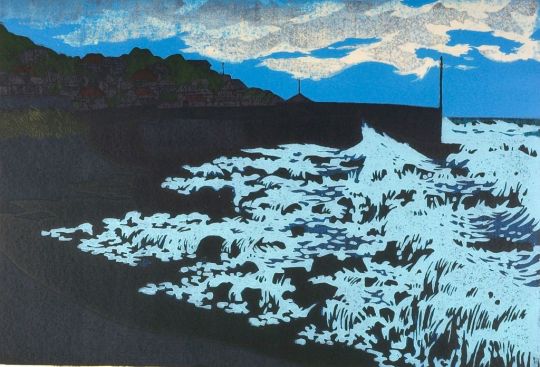
FUKUSHIMA Ichiro(福島一郎 Japanese, 1920-1975)
千葉の海 Wave in Chiba Shōwa era, 1926-1989 woodbrock print; ink and color on paper 38.1 x 54 cm via
87 notes
·
View notes
Text
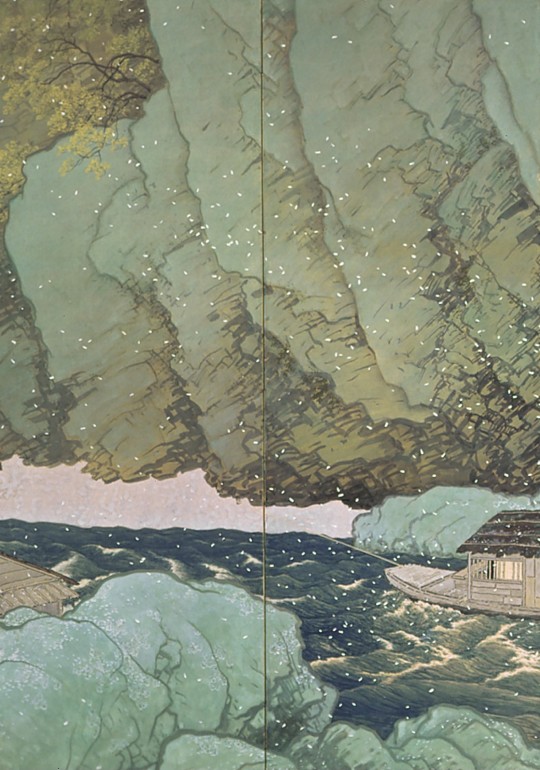

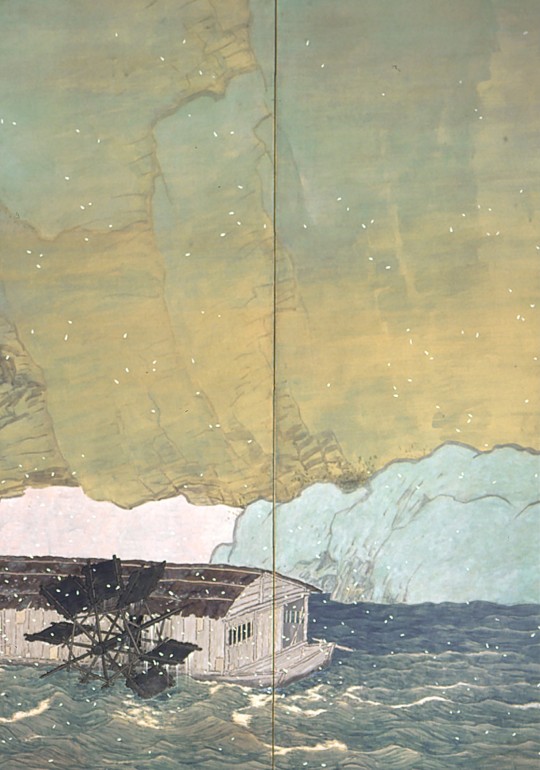

Right panel of the Parting Spring | 1916
Kawai Gyokudō
#Kawai Gyokudō#japanese art#spring#川合 玉堂#行く春#nihonga school#meiji period#shōwa era#japanese painting#1910s#early 20th century#art#byōbu#japanese folding screen#💮💮#art history
16 notes
·
View notes
Text
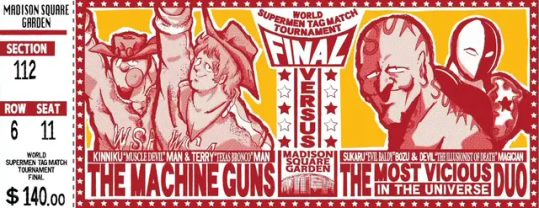
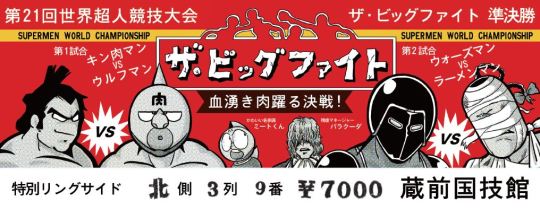


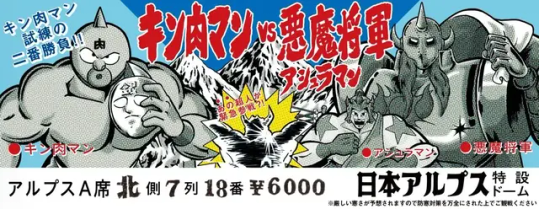
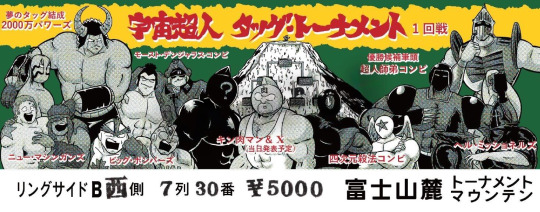
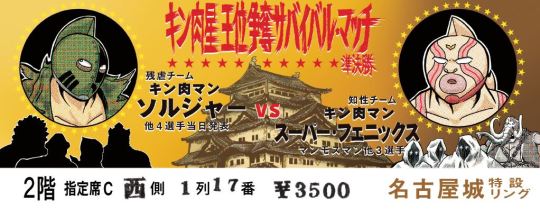
Shōwa-era styled bookmarks that were included in some printings of Gakken's Kinnikuman Technique Encyclopedia, designed by Yoshiyuki Yoshimura.
#kinnikuman#they look like actual NJPW tickets from the 70's that's so freaking cool#i'll stop spamming the tag now i promise
43 notes
·
View notes
Note
Hi. I apologize for the delayed response. I've been busy with Lunar New Year celebrations, and unfortunately, I haven't had the chance to check Tumblr until now. Here are the links that I sent in the foreshadowing ask https://www.tumblr.com/maoam/740334141571219456/chapter-182-beginning-of-sasuke-retrieval?source=share and https://maoam.tumblr.com/post/689252113529847808/narutos-feelings-in-kage-arc. I also apologize that I should have considered the possibility of you being wary about clicking on unknown links, especially given the current complex state of network security. I simply wanted to ensure my ask appeared tidy.
Hello there, I know you sent me an ask a long time ago about my opinion on these posts, I don't know Japanese so I can't say for sure if what she translated is correct.
What I can tell you, is that suicide amongst Japanese warriors was a practice that was considered the epitome of self-sacrifice towards an ideal. It was also an undying proof of loyalty, the ethos of Bushidō:
Ideas of the samurai code formalized earlier samurai moral values and ethics, most commonly stressing a combination of sincerity, frugality, loyalty, martial arts mastery, honor until death, "bravery", and "loyalty to the samurai's lord." The idea of a samurai code or codes was developed and refined centuries before the Edo period in the Kamakura period. (Source)
Seppuku (切腹, lit. 'cutting [the] belly'), also called harakiri (腹切り, lit. 'abdomen/belly cutting', a native Japanese kun reading), is a form of Japanese ritualistic suicide by disembowelment. It was originally reserved for samurai in their code of honour, but was also practised by other Japanese people during the Shōwa era (Source)
I don't understand the comparison, regardless. Why do they claim a character (Darui) speaking of double suicide directly relates to Naruto speaking of dying alongside Sasuke (they used Japanese raws in one image, not in the other one, so I'm not sure the possible interpretation of the Japanese writing, did Naruto use the same "心中" that Darui used?).
The first example they present is from a specific character and his arc (Shikamaru), is he who introduces the notion (women being a problem), and is he who closes it, modifying his views (for a specific woman, Temari).
In the second case, it's Darui who introduces the notion (in a single bubble speech, not an entire page like Shikamaru to convey the relevance of his views), so how come is Naruto the one who closes it?
There's no mention of suicide, either, Naruto claims they'll die together, but the context implies a clash, a fight between them both, not a double suicide; furthermore, Naruto's statement is "If we really do take this all the way to the end, and we both die..." He's not choosing to die, and he's not looking forward to it either, he's listing it as a possibility, that if it happened, it'll mean that in the next life, they'd have no burden of being an Uchiha or a jinchüriki, being able to understand one another without that weight upon them. Having a "clean slate" to understand one another, of sorts...
Kishimoto used the name Monzaemon Chikamatsu as the creator of puppetry ninjutsu, and he is one of the most well-respected Japanese authors. Indeed, Chikamatsu was better known for his double-suicide stories (alongside his reflection of commoners within his plays), but Kishimoto likely used this name because Chikamatsu was, well, a japanese playwright of the jōruri, puppet theatrical art, ancestor of bunraku and kabuki; so likely his homage has more to do with Chikamatsu being "the father" of puppet plays, and less to do with the idea of "double suicide" (Chikamatsu is also mentioned in a completely different arc by Sasori when fighting Chiyo, there's no mention about his stories but rather, his relevance as a puppeteer).
About the second post... I don't know what to say, Hinata confesses as she ends her speech with "I love you, Naruto-kun", while Naruto finishes it with "I'm happy I knew you", the speeches are similar as they both focus on the influence of the other person in their lives and how they inspired them to move forward in their goal; they both idealized the other (Hinata -> Naruto / Naruto -> Sasuke) so in that front, I understand the parallelism.
Naruto uses this speech to morally downgrade Sasuke ("one bad move... and I could have been like you..."). Hinata's confession focuses on how she wants to be beside Naruto, moving alongside him, Naruto's speech is mostly about how he wants to "surpass" Sasuke (their fallout starts when Sasuke refuses to acknowledge Naruto).
I don't understand the "notice how Hinata is facing away from Naruto while confessing, while Naruto is facing Sasuke. It’s the same thing whenever Sakura is confessing, Sasuke always gives her his back. This is again intentional from Kishi." The reasoning is different: Sasuke turns his back towards Sakura because he doesn't want to face her (there's rejection, yes), and Hinata has her back turned because she's facing Pain. Naruto is paying attention to her. Meanwhile, Sasuke and Naruto are facing one another because they're the ones about to fight, so the context in each situation is completely different.
8 notes
·
View notes
Text
weeb becoming more nationalistic and militaristic: hehe, entering my Shōwa era!!!🤪
on-looker 1: did he say shower or Shōwa??
on-looker 2: Shōwa.
on-looker 1: dammit.
9 notes
·
View notes
Text
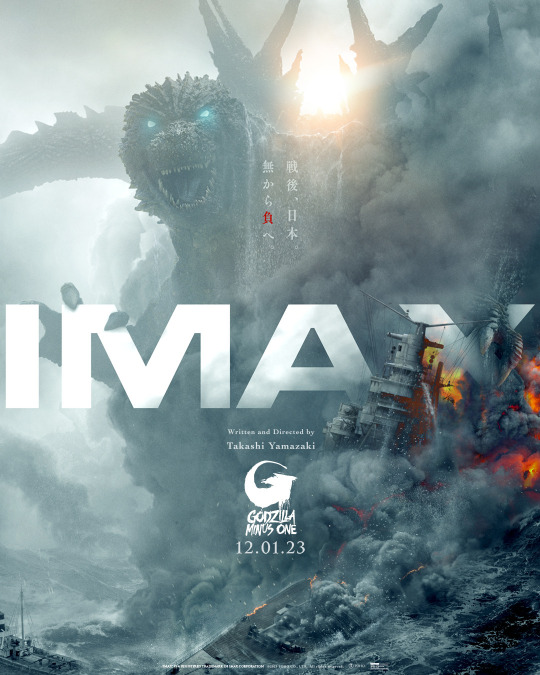
Godzilla Minus One (2023)
Watched: 11/29/2023
Format: AMC IMAX
Viewing: First
Director: Takashi Yamazaki
Where to start?
Over the years, Godzilla has been many things. Like Batman, he's been a children's character while also being a thing adults could appreciate. But he's also been cast as a walking analogy in two very, very good films (Gojira and Shin Godzilla), a villain in others (Godzilla Returns and Raids Again), a dad (Son of Godzilla) a hero (most of the Shōwa era), a goof, a buddy, a ruffian...
The American-produced Godzilla movies have done well financially, but, to me, struggled with an actual story until Kong vs. Godzilla. But it would be misleading to say the Toho Studios produced films didn't struggle with same. The Toho movies responded to the challenge by getting progressively crazier as the need to fill screen time with something other than expensive monster fights (models and custom 7' rubber suits are not cheap) became a clear necessity.
To fill that run time*, both US and Toho films needed a story for humans - humans that Godzilla likely will not even be aware of during the course of the film - that is compelling and meaningful. But, man , have the results been mixed. You get aliens, faeries, conspiracies, what-have-you. And some of that is great! Final Wars is like a party of a movie. Watch it sometime.
Meanwhile, Toho seems to have taken the licensing of Godzilla to Legendary and the US produced releases since 2014 to take a step outside of themselves and think about what would make a kick-ass Godzilla film. Heck, what would make a *film* rather than an entertaining outing for the kiddies (and, let's be honest, me). Thus, a few years ago, we got Shin Godzilla, which was absolutely terrific, in my opinion. Harkening back to 1954, it was a modern solo Godzilla outing, and more about how the humans on the ground deal with a huge analogy for recent world events (at minimum for the Fukushima disaster and Japan's official response) wandering through their backyard .
Sure, the Godzilla in it seemed like a mindless engine of destruction and looked weird as hell, but that movie just works. I dug the leads, the story, the analogies, the whole ball of wax. The human story was compelling and frightening, Godzilla a force of nature.
I figured we'd get a direct sequel, but that isn't what happened. Instead, Toho took a step back, and said "eh, let's just do it fresh again". Which - respect, man. Do whatever you want.
So, Wednesday, I made The Admiral go to the movies with me, and we saw an IMAX screening of Godzilla Minus One (2023).
I'd seen good, early reviews, but these were mostly die-hard G-fans, and I didn't particularly expect to get a straight answer. There's a difference between "a good movie" and "man, I like watching monsters on a screen", and that differentiation isn't always made in the Godzilla-sphere (and, often, the genre-media-sphere in general).
What I can say is that at the end of this year, Godzilla Minus One will be in my top 5 movies seen in 2023. Which - no shock, Shin Godzilla got similar high marks. But, it's also true that I'm not sure I didn't like Godzilla Minus One (2023) a slight bit better than Shin Godzilla.
As trailers would suggest, G-1 is a period piece. The movie takes place roughly between late 1944 and end of 1947, I think. The "Minus One" of the name is that, hey, Tokyo is already devastated, or at zero. And then G shows up, and, well... it just got worse. We're now at -1.
The movie centers on a Kamikaze pilot who chooses not to fulfill his mission, whether it's fear or a sense this is a waste of his own life here at the end of the war (both, really) he heads into a small island airstrip/ repair hut where he's violently introduced to much smaller version of Godzilla than what we're used to. This is Godzilla's original, dino-sized form.
As one of two survivors of the incident, and a survivor of the war (and one tapped to explicitly *not* survive and protect Nippon), Shikishima is dealing with PTSD and Survivor's Guilt, mixed with his uncertainty of who he is in this post-war world. Stumbling across a young (let's be honest, beautiful) woman. Noriko, who has picked up a loose baby in the wreckage of Tokyo, the three form a sort of family unit, building a shack and then home as Shikishima finds work on a boat clearing the sea of mines laid by both Japan and the US.
Shikishima forms a bond with his boat-mates, and life is beginning to turn around, even if he can't let go of the war and his need for closure. That trauma is preventing him from pursuing his feelings for Noriko and rejecting the baby as a surrogate daughter.
Meanwhile, unknown to all, Godzilla was hanging out at Bikini Atoll when the US thought to test a bomb, and we get our now Jumbo Sized Godzilla - going from T-Rex size to G 1954 size.
Anyhoo... Godzilla does show up.
Like I say, Godzilla has been many things over the years. Here, he's a raging, atomic-fueled engine of fury, not the hauntingly eye-dead monster of Shin Godzilla. He's well aware of what he's doing and why you need to get the @#$% out of his way as a large creature claiming new territory and not liking all these little humans who are in his way with their stupid buildings. It's not personal, but that doesn't mean he has a passive bone in him - this Godzilla is not to be crossed.
The design is closer to the 1990's style than Shin or Monsterverse Godzilla, and that's a good thing. There are definitely unique characteristics - plate placement, head size, scaliness - but most noticeable to me was the eyes. The suit Godzillas began having more expressive eyes in the Hesei and Millenium era, but here, there's a deadliness to his stare His eyes track the humans or any perceived annoyance or threat, and they are red/ gold eyes of a very pissed off creature.
For what this movie is about - the melodrama/ drama of the survivors, fallout of war, and the need to now combat a legitimate threat to all of Japan (this is an oversimplification, but bear with me) - this depiction of Godzilla is perfect. The monster is a product of the war and man's folly - mutated by the bomb, he reflects some of the 1990's take on Godzilla's WWII origins. But as a character, he's really a weapon of mass destruction with an agenda, and that agenda does not care about humans. If he is a "god", he's not concerned with us, and much like bugs living in your house, he's going to get rid of these humans.
The break to the third act occurs after Godzilla's Tokyo debut, reminiscent of the 1954 film and directly referencing it in visual, audial and musical queues. With modern CGI, it's not a suit actor stepping through sets, it's a living being wandering through Ginza as the locals, truly rampaging rather than clumsily knocking stuff over.
And, his atomic breath in this film may not be the spectacular laser-light show of Shin Godzilla, but it's an extension of his mutation coming from the bomb, and - narratively - an extension of the horrors of Hiroshima and Nagasaki. I won't go into detail here, but it's *scary* when you see G charging up (with a really innovative charge-up sequence) and cut loose.
He also seems, by all counts, invulnerable. It's not just his sheer size, but that he seems to heal from wounds with no trouble. So, do all the damage you want, he's going to come back from it and be pissed as hell you even tried.
All of this feeds into the actual plot of the film, which is really about dealing with the loss of WWII and the damage the war (which this movie freely indicates Japan started) did to the country and to the people. Survivors of the war come home to find their homes gone, their relatives dead. And for what?
I've spoken with my fellow Godzilla fan, Stuart, who has a better grip on Japan than I do (he resided there for a bit), and his feeling was this was a surprising take - and perhaps a very modern/ recent one. Centering the film on a "failed" kamikaze was not something he felt Japan would have done 30 years ago, but I think - narratively - it's an amazing choice. The Imperial dreams of Japan now long in the past, Toho can reframe the story to be about choosing to fight when the fight is a good one, even if seemingly hopeless.
And, man, when Godzilla is done with Ginza, it sure does feel hopeless, and any plan you put on the table is bound to fail.
I don't know a ton about Japan's feelings about how its government selectively issues information, or how they feel about the US as an occupational force in the MacArthur or modern era, but the film sidelines both. The Japanese government seems frozen by the attack, and the US is concerned large-scale naval maneuvers will trigger a war with Russia (not an unreasonable concern). While a US version might be about bringing all three together to fight Godzilla, this film is about the veterans overcoming their grief and shame to fight again.
Oh, and there's a very real semi-experimental plane that I was vaguely aware of, but thought was a German design, that appears in the back 1/3rd of the film that got my aviation-buff dad to make an audible "wow!" when it showed up.
Anyway, the movie drew a thunderous round of applause from my audience, which was - I will say - an audience of surefire Godzilla fans and their friends dragged to the movie. Lots of Godzilla shirts and whatnot. But it was also the 5:00 PM show on the day of the movie's release.
SPOILERS
Look, sometimes we outsmart ourselves and think we're too clever for the emotional levers that can get pulled in a movie, and if a movie has too much of a feel-good ending, it doesn't feed our desire to feel like film fans who can't be duped by emotional manipulation. But... gang, that's emotional manipulation, too.
I won't say I openly wept during the movie, but I did get choked up a few times. In a Godzilla movie! Because it's really about dealing with trauma, so seeing Shikishima deal with his, receive forgiveness and a path to happiness when I was 90% sure this movie was about to show a noble sacrifice... man. It really says a lot about what the movie-makers wanted to convey. And stuff that at the end of the day I personally want to believe.
END SPOILERS
I've watched a *lot* of Godzilla movies - probably all but one or two of the overall output of 30-odd movies over 70 years. At the end of the day, why I liked Godzilla Minus One this much was simple: story and character.
Call it melodrama, but the drama of this movie is really taking place inside a tiny house and on a boat, the cast has issues that understandable, is a solid mix, and I cared about everyone on screen. The performances are heightened a bit, perhaps, but the characters are likable and feel believable. And, much like Jaws or other movies that work despite the sci-fi, horror or other elements, you can both draw in your audience and sell something wild if the audience is pulling for these people on screen. And that's something Gojira understood in spades. As does this movie.
Anyway, this is now my second favorite Godzilla film. If it's better - to me - than Shin Godzilla, it's that the movie works so well not just as analogy, but as a deep character film while also providing genuine thrills with the Godzilla sequences.
I've tried to spoil all that as little as possible, because I'd encourage you to go see it. It's just a solid movie all around.
* we also have to ask the realistic question of "how exciting would it really be to watch two rubber monsters fight for 90 minutes?".
The Signal Watch blog posts regularly!
10 notes
·
View notes
Text
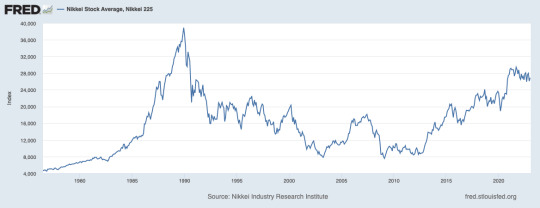
The Shōwa era ended on January 7, 1989, which is pretty close to the NIKKEI 255 peak in December. Then Heisei started and the stock market “became flat”...
28 notes
·
View notes
Text
Compiled all the ratings for that godzilla movie review montage I watched the other week, here's the list (also includes the average for each era (long, so under a readmore):
[Godzilla vs Kong (2021) review here. The rest of the reviews were from this video]
Shōwa Era (1954-1975) - 3.2/5
Godzilla (1954) - 5/5
Godzilla Raids Again (1955) - 1/5
King Kong vs. Godzilla (1962) - 4/5
Mothra vs. Godzilla (1964) - 4/5
Ghidorah, the Three-Headed Monster (1964) - 3/5
Invasion of Astro-Monster (1965) - 4/5
Ebirah, Horror of the Deep (1966) - 2/5
Son of Godzilla (1967) - 4/5
Destroy All Monsters (1968) - 3/5
All Monsters Attack (1969) - 2/5
Godzilla vs. Hedorah (1971) - 3/5
Godzilla vs. Gigan (1972) - 3/5
Godzilla vs. Megalon (1973) - 3/5
Godzilla vs. Mechagodzilla (1974) - 4/5
Terror of Mechagodzilla (1975) - 3/5
Heisei Era (1984-1995) - 3.5/5
The Return of Godzilla (1984) - 4/5
Godzilla vs. Biollante (1989) - 4/5
Godzilla vs. King Ghidorah (1991) - 4/5
Godzilla vs. Mothra (1992) - 3/5
Godzilla vs. Mechagodzilla II (1993) - 4/5
Godzilla vs. SpaceGodzilla (1994) - 3/5
Godzilla vs. Destoroyah (1995) - 4/5
Godzilla (1998) - 2/5
Millennium Era (1999-2004) - 3.167/5
Godzilla 2000 (1999) - 3/5
Godzilla vs. Megaguirus (2000) - 2/5
Godzilla, Mothra and King Ghidorah: Giant Monsters All-Out Attack (2001) - 4/5
Godzilla Against Mechagodzilla (2002) - 3/5
Godzilla: Tokyo S.O.S. (2003) - 3/5
Godzilla: Final Wars (2004) - 4/5
Reiwa Era (2014-present) - 3.43/5
Godzilla (2014) - 4/5
Shin Godzilla (2016) - 5/5
Godzilla: Planet of the Monsters (2017) - 2/5
Godzilla: City on the Edge of Battle (2018) - 3/5
Godzilla: The Planet Eater (2018) - 3/5
Godzilla: King of the Monsters (2019) - 4/5
Godzilla vs Kong (2021) - 3/5
Additionally, here's the movies reordered based on rating (year release is the secondary order within each rating):
5 stars:
4 stars:
Godzilla (1954)
Shin Godzilla (2016)
3 stars:
King Kong vs. Godzilla (1962)
Mothra vs. Godzilla (1964)
Invasion of Astro-Monster (1965)
Son of Godzilla (1967)
Godzilla vs. Mechagodzilla (1974)
The Return of Godzilla (1984)
Godzilla vs. Biollante (1989)
Godzilla vs. King Ghidorah (1991)
Godzilla vs. Mechagodzilla II (1993)
Godzilla vs. Destoroyah (1995)
Godzilla, Mothra and King Ghidorah: Giant Monsters All-Out Attack (2001)
Godzilla: Final Wars (2004)
Godzilla (2014)
Godzilla: King of the Monsters (2019)
2 stars:
Ghidorah, the Three-Headed Monster (1964)
Destroy All Monsters (1968)
Godzilla vs. Hedorah (1971)
Godzilla vs. Gigan (1972)
Godzilla vs. Megalon (1973)
Terror of Mechagodzilla (1975)
Godzilla vs. Mothra (1992)
Godzilla vs. SpaceGodzilla (1994)
Godzilla 2000 (1999)
Godzilla Against Mechagodzilla (2002)
Godzilla: Tokyo S.O.S. (2003)
Godzilla: City on the Edge of Battle (2018)
Godzilla: The Planet Eater (2018)
Godzilla vs Kong (2021)
1 star:
Ebirah, Horror of the Deep (1966)
All Monsters Attack (1969)
Godzilla (1998)
Godzilla vs. Megaguirus (2000)
Godzilla: Planet of the Monsters (2017)
Godzilla Raids Again (1955)
4 notes
·
View notes
Text
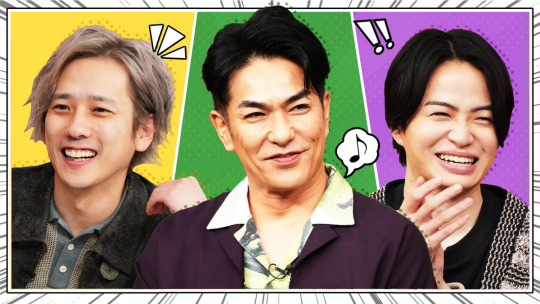

On today's edition of Nino-San.
Guest of the episode #kazukikitamura.
Nino with silver hair
"I want to become a good singer."
Fuma also revealed his amazing past 🤭…
The best shrimp dishes and retro goods from the Shōwa era 🥰.
Ebi Katsu✨ Ebi Katsu's sandwich made an appearance in the studio.
Here's something I didn't expect.
Traditions #ninosan, also going on as usual😍.
Tomorrow's Petit Fine.
Something's gonna happen!
Join the #kazukikikitamura and the miracle relay 😍.
Nino struggles with finger gymnastics.
Fuma is somewhat of a coin magician.
Kitamura-san, who carries everyone's thoughts and feelings….
Daruma's rapid resetting continues.
And finally, for some reason, team purses have appeared!
This is definitely a lot of fun.
The programme airs every sunday at the 10.25. a.m. on the japanese time and on 02.25. a.m. on the european time on the "Nippon TV". Don't miss it!
#Ninomiya Kazunari#Arashi#Kikuchi Fuma#Sexy Zone#Kazuki Kitamura#Nino-San#Japanese Entertainment Programme#NTV
2 notes
·
View notes
